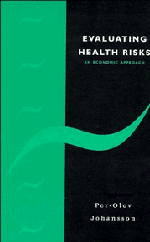Book contents
- Frontmatter
- Contents
- Preface
- 1 Introduction
- 2 Some basic tools and concepts
- 3 Evaluating health changes in a certain world
- 4 Money measures in a risky world
- 5 Evaluating health risks: practical methodologies
- 6 Contingent valuation studies of health care
- 7 Aggregation
- 8 Further evaluation issues in a risky world
- 9 Concluding remarks on related approaches
- Notes
- Bibliography
- Index
2 - Some basic tools and concepts
Published online by Cambridge University Press: 03 May 2011
- Frontmatter
- Contents
- Preface
- 1 Introduction
- 2 Some basic tools and concepts
- 3 Evaluating health changes in a certain world
- 4 Money measures in a risky world
- 5 Evaluating health risks: practical methodologies
- 6 Contingent valuation studies of health care
- 7 Aggregation
- 8 Further evaluation issues in a risky world
- 9 Concluding remarks on related approaches
- Notes
- Bibliography
- Index
Summary
In order to derive money measures of the value of changes in health, a number of essential tools and definitions are required. Instead of waiting until these different concepts arise in the text before introducing them, this chapter presents the basic tools used in the subsequent analysis.
The chapter is structured as follows. The first section considers an individual's utility maximization problem within a single-period context. The individual consumes private commodities and values his or her health, and in this section, the health status is treated as fixed by the individual. In the second section, this assumption is abandoned, and a simple health production function approach is presented and discussed. The third section introduces discrete-time intertemporal models, and points out some of the complications which time adds to maximization problems. In the fourth section, risk is introduced, and basic concepts such as expected utility and risk attitudes are defined. The fifth section applies these concepts to problems such as insurance and utility maximization when the probabilities of different outcomes are endogenous. Finally, the sixth section is devoted to some more complex intertemporal utility maximization problems.
Utility maximization
Let us consider an individual consuming n different private commodities xi, where i = 1,…,n. These can be bought in non-negative quantities at given, fixed, strictly positive prices pi. The individual also values his or her health status, which is ‘normalized’ so as to range between 0 and some finite positive level, which is often arbitrarily set equal to 1, where 0 is the worst possible health status and 1 is the best possible health status.
Information
- Type
- Chapter
- Information
- Evaluating Health RisksAn Economic Approach, pp. 9 - 32Publisher: Cambridge University PressPrint publication year: 1995
